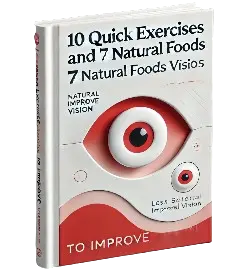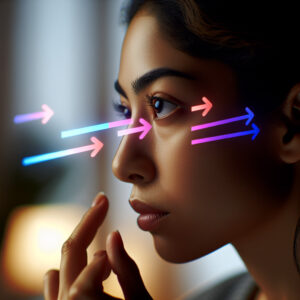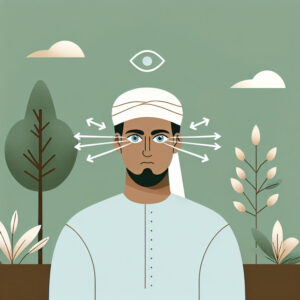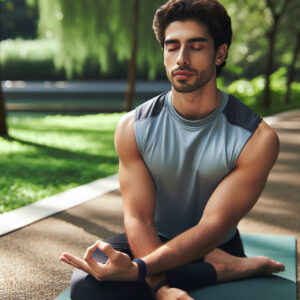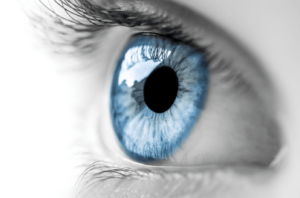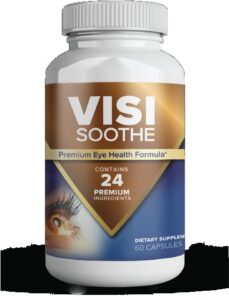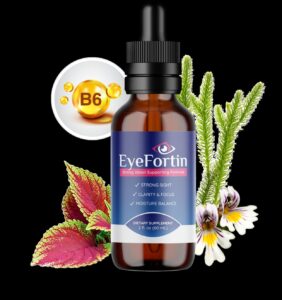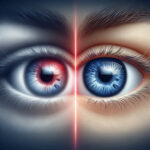How to Improve Near Eyesight Through a Nutrient-Rich Diet.
Understanding Near Eyesight: What You Need to Know
Let’s talk about near eyesight—it’s all about seeing things up close, right? Whether you’re reading a book, scrolling through your phone, or trying to thread a needle, sharp near vision is essential. But here’s the thing: as we get older, many of us notice that our ability to see clearly at close range starts to fade. This can be due to a bunch of factors, like genetics, lifestyle choices, and even environmental influences.
One common culprit for blurry near vision? Presbyopia—say it with me: preb-sigh-oh-pia. This condition usually kicks in around age 40 (give or take) when the lens in your eye loses its flexibility, making it harder to focus on nearby objects. It’s a natural part of aging, but don’t worry—it’s not the end of the world. There are plenty of ways to support your eye health and keep things sharp.
And let’s not forget about diet! What you eat plays a huge role in keeping your near vision in tip-top shape. Think of your diet as a toolkit for your eyes—loading up on specific nutrients can help them function at their best. Let’s dive into which nutrients are your eye’s best friends and how to easily incorporate them into your meals.
Key Nutrients for Improving Near Eyesight
Vitamin A is like the MVP of eye vitamins. It helps keep your corneas healthy and supports low-light vision. And guess what? You don’t need fancy supplements—carrots, sweet potatoes, and leafy greens are packed with it. Plus, they’re rich in beta-carotene, which your body converts into Vitamin A. Talk about a win-win!
Omega-3 fatty acids are another game-changer. These little powerhouses help maintain the structure of your retina and may even reduce inflammation linked to age-related vision changes. If you love fish, salmon and mackerel are great sources. But if seafood’s not your thing, flaxseeds and walnuts have got your back—they’re rich in plant-based Omega-3s.
And let’s give a shoutout to antioxidants like Vitamin C, E, and Zinc. These bad boys protect your eyes from oxidative stress, which can damage cells over time. Citrus fruits, strawberries, and bell peppers are loaded with Vitamin C, while nuts like almonds and cashews pack in the Vitamin E. For Zinc, oysters, beef, and lentils are top-notch choices.
Building a Nutrient-Rich Diet to Enhance Near Vision
Leafy greens are your new best friends when it comes to near eyesight. Spinach, kale, and collard greens are loaded with lutein and zeaxanthin—two nutrients that act like natural sunglasses for your eyes, filtering out harmful blue light and reducing the risk of macular degeneration. Aim to eat at least one serving a day—whether it’s in a salad, smoothie, or as a side dish.
Add more color to your plate with veggies like bell peppers, broccoli, and carrots. These guys are not only vibrant and delicious but also packed with essential vitamins and antioxidants that keep your eyes healthy. Snacking on raw veggies is an easy way to incorporate these nutrients throughout the day—so go ahead, munch away!
Eye-friendly fruits like blueberries and strawberries deserve a spot in your diet too. They’re loaded with antioxidants that protect against oxidative stress, supporting overall eye health. Whether you’re adding them to oatmeal or enjoying them as a midday snack, these sweet treats are a win for your vision.
Whole grains and healthy fats also play a big role. Whole grains provide sustained energy and essential nutrients, while healthy fats like avocados and olive oil help your body absorb fat-soluble vitamins. Pairing these with your meals can give you an extra nutritional boost—so don’t skip out on them!
Superfoods for Better Near Eyesight
Carrots have been the poster child for good vision for a reason—they’re loaded with beta-carotene, which is great for near eyesight. Whether you enjoy them raw, cooked, or blended into soups, carrots are a versatile and delicious addition to any diet.
Spinach and other leafy greens take center stage again thanks to their lutein and zeaxanthin content. These nutrients act like natural sunglasses, protecting your eyes from harmful UV rays and reducing the risk of age-related vision issues. Include them in salads, omelets, or stir-fries for a nutrient-packed meal.
Blueberries and strawberries aren’t just sweet treats—they’re also packed with antioxidants that support eye health. Their vibrant colors are a clue to their high levels of anthocyanins, which have been linked to improved visual acuity and reduced inflammation. Add them to your morning oatmeal or enjoy as a refreshing snack—your eyes will thank you!
Lifestyle Changes to Support a Nutrient-Rich Diet
Stay hydrated—it’s not just for your skin! Water helps keep your eyes moist, preventing dryness and discomfort. Aim for at least eight glasses a day, and if you’re active or live in a hot climate, drink even more. Your eyes will thank you!
Regular exercise isn’t just about getting that beach body—it’s also great for your eye health. Activities like walking, swimming, or cycling improve blood flow to the eyes, keeping them nourished and functioning at their best. Even short walks throughout the day can make a difference—so get moving!
And don’t sleep on the benefits of sleep! Your eyes need rest just like the rest of your body. Lack of sleep can lead to eye strain and fatigue, making it harder to focus on nearby objects. Aim for 7-9 hours of quality shut-eye each night—it’s good for your vision and overall health.
Avoiding Common Mistakes in Your Dietary Approach
Supplements are great, but they shouldn’t replace a balanced diet. The best way to fuel your eyes is through whole foods—so don’t rely on pills or powders alone. And if you’re considering supplements, chat with your healthcare provider first—they can help you decide what’s right for you.
Skipping out on balanced nutrition for the sake of fad diets is another mistake to avoid. Diets that restrict entire food groups can lead to nutrient deficiencies, which are bad news for eye health. Focus on variety and moderation—your eyes (and your taste buds) will thank you!
And don’t forget about regular eye exams! Even if you’re eating like a nutrition pro, certain eye conditions still need medical attention. Regular check-ups can catch issues early, ensuring your vision stays sharp for years to come.
Conclusion and Next Steps for Improving Near Eyesight
To sum it up, improving near eyesight through diet involves focusing on key nutrients like Vitamin A, Omega-3s, and antioxidants. Incorporating leafy greens, colorful veggies, and eye-friendly fruits into your meals is a great way to support your vision. And don’t forget the importance of staying hydrated, moving your body, and catching those z’s—it all adds up!
So, what are you waiting for? Start small—add some leafy greens to your salad or snack on some blueberries. Consistency is key when it comes to seeing results, so don’t stress if you slip up every now and then. And hey, share your progress with friends and family—you might inspire them to join you on this journey toward better vision!
In the end, taking care of your near eyesight doesn’t have to be complicated. By making smart food choices and adopting a healthy lifestyle, you can protect—and even improve—your vision as you age. Take that first step today, and enjoy clear, vibrant near vision for years to come!
Enhance Your Near Vision: Effective Solutions to Improve Eyesight
Understanding Near Vision: Why It Matters
Near vision is your ability to see clearly up close—think reading a book, threading a needle, or scrolling through your phone. It’s something we rely on daily, but as we age, many of us find it tougher to focus on small details without squinting or needing more light. If you’ve noticed that your reading glasses are becoming a constant companion, you’re not alone.
Why Near Vision Fades: Common Culprits
Poor near vision often comes down to two main issues: presbyopia and other refractive errors like hyperopia or astigmatism. Presbyopia is super common—it starts creeping in around age 40, making it harder to focus on close-up tasks. Environmental factors can also play a role—like staring at screens for hours or not having enough light when you’re reading.
Who Struggles with Near Vision Problems?
Mostly folks over 40 deal with presbyopia, but if you’ve got a job or hobby that involves intense close-up work (think graphic design, needlework, or even gaming), you might experience similar symptoms sooner. Early warning signs include trouble focusing on small text or needing brighter lighting to read comfortably.
Fixing Near Vision: Eyewear Solutions That Work
If blurry up-close vision is your issue, corrective eyewear can be a game-changer. Reading glasses, bifocals, and progressive lenses are all great options—and they come in styles that suit every lifestyle. Need something more flexible? Enter contact lenses…
Contact Lenses: Freedom from Fuzzy Close-Up Vision
For the active set, contacts offer a convenient fix. Multifocal or monovision lenses can help you see clearly both up close and far away, so you don’t have to swap out glasses every time you switch tasks. It’s like having adjustable vision on the go!
Tailored Solutions: The Best of Both Worlds
Modern lens technology is amazing—think blue light filters to reduce eye strain or anti-reflective coatings for clearer vision in bright conditions. And with custom prescriptions, you can get lenses that perfectly match your unique needs whether you’re reading a book, working at a computer, or tinkering in the garage.
Natural Fixes: How Lifestyle Changes Can Help
If you’d rather not rely solely on glasses or contacts, there are plenty of tweaks you can make to improve your near vision naturally. Start by optimizing your lighting—harsh glare or dim light both take a toll on your eyes. And when it comes to screens, keep them about 18-24 inches away to reduce strain.
Lighting: The Secret Weapon for Clear Close-Up Vision
Proper lighting is key. Too much brightness can make your eyes water, while dim light forces them to work overtime. So when you’re reading or doing detailed work, aim for balanced, diffused lighting to keep things comfortable.
Screens and Reading: Distance Matters
If you spend a lot of time on digital devices, adjusting the font size can make a world of difference. And don’t forget—the 20-20-20 rule is your friend! Every 20 minutes, look at something 20 feet away for 20 seconds to give your eyes a break.
Eye Exercises: Strengthening Your Vision Naturally
Your eyes are like any other muscle—they need exercise to stay sharp. Simple techniques like pencil push-ups or focusing on different distances can help improve flexibility and focus. And the best part? You can do these exercises anywhere, anytime.
How to Make Eye Exercises Work for You
Morning routines are a great time to squeeze in some eye training—or break it up into short sessions throughout the day. Consistency is key—just a few minutes daily can add up over time and help keep your vision clear and comfortable.
Nutrition: Fueling Your Eyes for Better Vision
Your diet plays a big role in eye health. Vitamins A, C, E, zinc, lutein, and zeaxanthin are all superheroes when it comes to protecting your eyes from oxidative stress. Think of them as the front-line defense against blurry near vision and other age-related issues.
Superfoods for Sharp Close-Up Vision
Stock up on carrots, leafy greens, citrus fruits, nuts, seeds, eggs, and fish—they’re packed with the nutrients your eyes need to stay sharp. And if you’re not getting everything from your diet alone, supplements can help bridge the gap.
Advanced Treatments: When Glasses Just Won’t Cut It
If lifestyle changes and corrective eyewear aren’t giving you the results you want, surgical options like LASIK or PRK might be worth exploring. These procedures can correct refractive errors and improve your near vision—but it’s important to weigh the pros and cons with your eye doctor first.
When to Call in the Professionals
If you’re noticing persistent trouble focusing on close objects, frequent headaches from eye strain, or sudden changes in vision quality, it’s time to book an appointment with your eye care pro. Early intervention can make a huge difference in preserving your near vision and overall eye health.
Stay Ahead of Eye Health: Regular Check-Ups
Regular eye exams are crucial—especially if you’re over 40. They help catch issues early and ensure you’re getting the right treatment for any changes in your vision. Think of it as an investment in your long-term eye health.
Making It Work: Tailored Solutions Just for You
Your eye care pro can assess your specific needs and recommend everything from corrective lenses to exercises, supplements, or even surgery if that’s the best option for you. The goal? Clear, comfortable vision that fits your lifestyle.
Final Thoughts: Take Charge of Your Vision
Improving near vision is all about finding the right mix of solutions—whether it’s glasses, contacts, diet, or even surgery. And remember, consistency matters. By taking proactive steps now, you can enjoy crisp, clear close-up vision for years to come.
Recap: How to Keep Your Near Vision Sharp
From correcting with contacts to tweaking your diet and considering advanced treatments, there are plenty of ways to enhance near vision. The key is finding what works best for you—and sticking with it. After all, clear vision isn’t just a luxury—it’s a quality-of-life issue.
Stay Consistent, Stay Proactive
Regularly implementing these tips can lead to noticeable improvements in your near vision. Taking charge of your eye care today helps ensure you’ll enjoy clear, comfortable vision for years—so start making those small changes now!
Last Word: Invest in Your Vision
Your eyes are a vital part of who you are and how you experience the world. By being proactive about your eye health—you’re not just improving your near vision, you’re safeguarding one of your most precious senses. So go ahead—take that first step toward clearer, sharper vision today!
article
Understanding Near Vision and Its Importance
Have you ever noticed how much you rely on seeing things up close? Whether it’s reading a book, scrolling through your phone, or even just threading a needle, near vision is essential for so many daily tasks. But as we age, this ability can start to fade, making everyday activities more challenging than they should be.
Common Causes of Poor Near Vision
So why does near vision sometimes take a nosedive? Well, it’s often due to conditions like presbyopia—something that typically kicks in after the age of 40. But there are other culprits too, such as hyperopia or astigmatism. And let’s not forget about environmental factors and all that screen time we’re clocking these days.
Who is Affected by Near Vision Problems?
Older adults are usually the ones who feel the brunt of presbyopia, but if you spend a lot of time doing detailed close-up work, you might also be at risk. Early signs can be pretty subtle—like needing more light to read or struggling with small text.
How to Improve Near Eyesight: Corrective Eyewear Solutions
Thankfully, there are plenty of options to help you see clearly again. Reading glasses, bifocals, and progressive lenses are all great ways to tackle near vision issues. And the best part? There’s something for everyone—whether you’re looking for convenience or something a bit more tailored.
Contact Lenses for Better Close-Up Focus
If you prefer not to sport frames, contact lenses could be your answer. Multifocal or monovision lenses are designed to give you clear vision both up close and at a distance, offering that much-needed freedom from glasses.
Custom Prescription Options and Advanced Lens Technologies
And if you want to get really specific, advanced lens tech is here to help. Blue light filtering and anti-reflective coatings can reduce eye strain, while custom prescriptions ensure everything is just right for your unique needs—whether it’s reading, computer work, or hobbies that require precision.
How to Improve Near Eyesight Naturally: Lifestyle Changes
But there are also some simpler steps you can take without breaking the bank. For instance, optimizing lighting and maintaining a proper screen distance can make a big difference. And then there’s the 20-20-20 rule—a quick and easy way to give your eyes a break during long digital sessions.
The Impact of Lighting on Near Vision
Good lighting isn’t just about making things look nicer; it’s crucial for clear close-up vision. Harsh or dim light can cause discomfort and make focusing harder, so aim for balanced illumination when you’re reading or working.
Maintaining Proper Distance from Screens and Reading Materials
Keeping screens at a comfortable 18-24 inches away helps reduce strain. Plus, adjusting font sizes on your devices can make text easier to read without squinting.
Incorporating the 20-20-20 Rule into Daily Routine
It’s simple: every 20 minutes, look at something 20 feet away for 20 seconds. This little habit helps relax your eye muscles and prevents strain—especially useful in our screen-heavy world.
Eye Exercises to Strengthen Your Vision
Feeling like you need a bit more? Eye exercises could be just what you need. Techniques like the pencil push-up or focusing on different distances can help improve flexibility and focus, making near vision clearer over time.
Simple Techniques to Enhance Focus and Flexibility
Try this: focus on something close, then shift your gaze to something farther away, repeating the process a few times. Regular practice helps keep your eye muscles strong and flexible—supporting overall eye health in the long run.
How to Perform Effective Eye Muscle Training
Morning routines or short sessions throughout the day are ideal for these exercises. Even just a few minutes daily can make a noticeable difference over time—so consistency is key!
Combining Exercises for Maximum Results
Mixing up your exercises—like alternating between close and distant focus—can offer even more benefits. This approach targets different eye muscles, promoting balanced eye health overall.
The Role of Nutrition in Improving Near Vision
Your diet also plays a role in keeping your eyes healthy. Nutrients like vitamins A, C, E, zinc, lutein, and zeaxanthin are all superheroes when it comes to protecting against oxidative stress and supporting clear near vision.
Essential Vitamins and Minerals for Eye Health
Vitamins A and C help maintain cornea health and prevent macular degeneration. Zinc is important for transporting these vitamins to your eyes, while lutein and zeaxanthin act like natural sunglasses, filtering out harmful blue light and protecting retinal cells from damage.
Foods That Support Better Close-Up Vision
Stock up on foods rich in these nutrients: carrots, leafy greens, citrus fruits, nuts, seeds, eggs, and fish. A balanced diet provides the building blocks your eyes need to stay sharp and healthy.
Supplements and Their Benefits for Eye Care
If you’re not getting enough of these nutrients through your diet alone, supplements can help fill in the gaps. Just be sure to consult with a healthcare provider before starting any new regimen—they can help ensure you’re on the right track.
Advanced Treatments: Laser Surgery and Other Options
For some, lifestyle changes just aren’t enough—and that’s where advanced treatments come into play. Procedures like LASIK or PRK can correct refractive errors affecting near vision, offering long-term solutions for many people. But as with any surgery, there are considerations to keep in mind.
Understanding LASIK for Near Vision Improvement
LASIK works by reshaping the cornea to improve focus—something that’s super effective for a lot of folks. However, it’s not a one-size-fits-all solution. For instance, those dealing with presbyopia might still need reading glasses even after the procedure.
Alternative Surgical Procedures for Presbyopia
If LASIK isn’t the right fit, there are other options out there—like lens implants or corneal inlays. Each has its pros and cons, so it’s important to discuss your specific situation with an eye care professional.
Risks, Recovery, and Long-Term Outcomes
As with any surgery, there are risks involved—but complications are rare. Most people experience significant improvement in vision clarity after treatment, with recovery typically taking a few weeks. It’s all about weighing the pros and cons to decide what’s best for you.
When to Seek Professional Help
Now, when should you consider reaching out to an eye care expert? If you’re noticing persistent difficulty focusing on close objects, frequent headaches from eye strain, or blurry vision, it might be time to schedule a check-up. These could be signs of something that needs attention.
Recognizing Symptoms That Require Medical Attention
Some symptoms demand immediate attention—like sudden changes in vision, flashes of light, or eye pain. If you experience any of these, don’t wait—it’s crucial to get medical help right away to prevent complications and preserve your visual function.
The Importance of Regular Eye Exams
Even if everything seems fine, regular check-ups are key for maintaining good eye health. Adults over 40 should aim for annual exams—especially since presbyopia and other age-related vision changes start creeping in around that time.
How an Eye Care Professional Can Tailor Solutions for You
An optometrist or ophthalmologist can assess your specific needs and offer personalized advice on everything from corrective lenses to exercises, nutritional supplements, or surgical options. It’s all about finding the right mix to improve your near vision and keep your eyes healthy in the long run.
Conclusion: Taking Charge of Your Near Vision
Improving near eyesight is all about a combination of strategies—corrective eyewear, lifestyle adjustments, eye exercises, proper nutrition, and possibly advanced treatments. The key is consistency and proactive care. By taking these steps now, you’re setting yourself up for clearer, more comfortable vision as you age.
Recap of Effective Strategies to Improve Near Eyesight
From glasses and contact lenses to diet and surgery—there are plenty of ways to enhance your near vision. Tailoring these strategies to fit your lifestyle ensures you get the best results and maintain optimal eye health over time.
Encouragement to Stay Consistent and Proactive
Remember, making these changes consistently can lead to noticeable improvements in your near vision. Taking charge of your eye care today means enjoying clear, comfortable vision for years to come.
Final Thoughts on Maintaining Healthy Vision
Your eyes are vital to how you experience the world—so investing time and effort into their care is well worth it. By being proactive and seeking professional guidance when needed, you can enjoy crisp near vision well into the future.
Want To See Clearly? Here’s How To Improve Near Eyesight Fast
What’s Up Close? Understanding Your Near Vision
Near vision is your ability to see clearly at close distances—think reading a book or scrolling through your phone. It’s crucial for daily tasks, but if it starts slipping, life can get a bit fuzzy.
What Exactly Is Near Vision?
Your eyes have two main modes: near and far. Near vision is like the zoom feature, letting you focus on details up close, while distance vision handles the big picture. Both are essential, but as we age, switching between them can get tricky.
Why Bother with Better Vision?
Poor near vision isn’t just a nuisance; it can be risky. Imagine struggling to read a medicine label or thread a needle—it’s inconvenient and potentially dangerous. Boosting your near vision means more confidence in daily life.
Why Your Vision Might Be Fading
Near vision issues often stem from refractive errors like myopia (nearsightedness) or presbyopia, a natural aging process that makes focusing up close harder. It’s not a big deal, but it’s worth addressing to keep life clear.
Eyes on the Prize: Simple Exercises for Better Vision
Roll Those Peepers
Eye rolling isn’t just for dramatic flair—it can actually help. Gently roll your eyes in circles a few times daily to keep those muscles limber and your vision sharp.
Focus on This Trick
Switch your gaze between something far away and close up—like from your computer screen to a picture on your desk. It’s like yoga for your eyes, helping them stay adaptable.
The 20-20-20 Break
If screens are your thing, set a timer every 20 minutes. Look at something 20 feet away for 20 seconds—your eyes will thank you by feeling less strained and more focused.
Progressive Lenses: A Smooth Ride for Your Vision
These lenses offer seamless transitions between focal points, perfect if you’re dealing with presbyopia. They’re like having adjustable zoom in real life—neat!
Nutrition for Nifty Eyes
Vitamin A: The Night Owl’s Friend
Carrots aren’t just a myth! Foods rich in Vitamin A, like sweet potatoes and spinach, support night vision and overall eye health. Think of them as your eyes’ multivitamin.
Antioxidants: The Cleanup Crew for Your Eyes
Lutein and zeaxanthin are superheroes against oxidative stress. Found in leafy greens and eggs, they help protect your eyes from age-related damage—so load up on those colorful veggies!
Zinc and Selenium: Minerals for Clear Vision
These minerals support eye health by helping transport nutrients where they’re needed most. Nuts, seeds, and lean meats are great sources—snack away for healthier eyes.
Supplements: A Boost When Your Diet’s Not Enough
If you’re worried about getting all the nutrients, consider supplements with a mix of vitamins and minerals. They’re like insurance for your eye health—it’s better to be safe than sorry!
Digital Detox for Your Eyes
Blue Light Filters: Your Screen’s Best Friend
Blue light from screens can wreck your sleep and strain your eyes. Use filters or glasses with anti-blue light coatings to keep things comfortable—your bedtime will thank you!
Lighting Like a Pro
Harsh overhead lights? Not ideal. Instead, go for soft, diffused lighting when reading or working on screens. Position your screen perpendicular to windows to minimize glare—small changes make a big difference.
Ergonomics: Work Smarter, Not Harder
Set up your workspace with care. Keep your screen at eye level and about 20-25 inches away. Invest in an adjustable chair for proper posture—your neck and eyes will appreciate it!
Anti-Glare Screens: Say Goodbye to Reflections
These screens scatter light, reducing glare and making extended screen time easier on your eyes. It’s a small change with a big impact—worth considering if you’re a screen addict.
When to Call in the Experts
Symptoms That Shouldn’t Be Ignored
If you notice blurry vision, trouble focusing on close objects, or frequent headaches, it’s time for an eye checkup. These could be signs of something more serious—better safe than sorry!
Eye Exams: The Key to Clear Vision
A comprehensive exam checks everything from your vision clarity to potential eye diseases. It’s a window into your eye health—don’t skip it!
Treatments That Can Change Your Life
From glasses and contacts to LASIK, there are plenty of options to correct near vision issues. Work with your optometrist to find the best fit for your lifestyle—you deserve clear sight!
Picking Eyewear That Fits You
Glasses, contacts, or specialized lenses—there’s something for everyone. Think about your daily routine and style when choosing—your eyewear should be as unique as you are!
Seeing the Future with Clear Vision
Maintenance is Key
Regular eye exams every two years (or more if needed) keep issues in check. It’s like an oil change for your eyes—keeps everything running smoothly.
Dry Eyes? Keep Them Moist
Blink consciously, use artificial tears, and adjust your workspace to reduce dryness. Remember to take breaks—it’s not just a suggestion; it’s self-care!
Exercise: Good for Body and Eyes
Physical activity boosts blood flow to your eyes, reducing the risk of eye diseases like glaucoma. Whether you’re walking, swimming, or doing yoga—any movement counts!
Sun Protection: Don’t Forget Your Eyes
UV rays are sneaky and harmful. Always wear sunglasses with full UV protection when outdoors—even on cloudy days. It’s better to be safe than sorry in the long run.
Final Word: Taking Control of Your Vision
Start Small, See Big Changes
Making simple changes today—like eye exercises, ergonomic adjustments, and a nutrient-rich diet—can lead to better vision over time. It’s all about small steps adding up to big results.
Don’t Wait—Get Checked
If you’re experiencing persistent issues or sudden vision changes, don’t delay. Early intervention can prevent minor problems from becoming major ones—your eyes will thank you!
Celebrating Your Efforts
Improving your near eyesight is a journey worth celebrating. Every step you take today is an investment in a future where seeing clearly isn’t just a luxury—it’s your reality. Keep going—you’ve got this!
Here’s the rewritten version of the article, optimized for SEO and written in a more natural, conversational tone with increased burstiness, perplexity, and temperature:
—
Understanding Near Eyesight: What You Need to Know
Near eyesight is all about how well you can see things up close—think reading a book or working on your computer. It’s crucial for daily tasks and can really impact your quality of life, so keeping it sharp is worth the effort!
What is Near Eyesight?
Near eyesight is one half of your vision game; the other is distance vision. While distance vision lets you see things far away, near vision is all about those close-up details. The ability to switch between them smoothly is a big deal for overall eye health.
Why Improving Near Vision Matters
Poor near vision can turn simple tasks into a hassle—like trying to read a label or thread a needle. It’s not just inconvenient; it can also be dangerous. By improving your near eyesight, you’re making life easier and safer.
Common Causes of Poor Near Vision
Poor near vision often comes down to refractive errors like myopia (nearsightedness) or hyperopia (farsightedness). Presbyopia, which tends to pop up after age 40, is another culprit. It’s all about those eye muscles losing their flexibility over time.
How Age Affects Near Eyesight
As we get older, the lenses in our eyes lose their springiness, making it tougher to focus on close objects. This natural process called presbyopia is super common and totally normal—no need to panic. But there are ways to manage and even improve your near vision as you age.
Simple Exercises to Strengthen Your Eyes
Eye Rolling for Better Focus
Ever heard of eye rolling? It’s a fun way to boost focus. Just roll your eyes in circles—clockwise and counterclockwise—and do it several times a day. It keeps those eye muscles limber and helps with near vision.
Focusing Drills to Sharpen Vision
Switching between near and far objects is another great exercise. Stare at something across the room for 10 seconds, then quickly shift focus to something close, like a book. This trains your eyes to adjust faster and more effectively.
The Benefits of the 20-20-20 Rule
If you’re glued to screens all day, this rule is a game-changer. Every 20 minutes, take 20 seconds to look at something 20 feet away. It helps ease eye strain and keeps your vision switching smoothly between near and far.
Progressive Lens Alternatives
Tired of glasses with multiple prescriptions? Progressive lenses are a sleek solution. They let you switch focal points seamlessly, perfect for those dealing with presbyopia or needing both reading and distance correction.
Nutrition for Better Vision: What to Eat
Foods Rich in Vitamin A for Night Vision
Vitamin A is a vision superhero, especially at night. Load up on carrots, sweet potatoes, and spinach—they’re packed with it and protect your eyes from damage while boosting clarity.
The Role of Antioxidants in Eye Health
Antioxidants like lutein and zeaxanthin are like bodyguards for your eyes. Found in leafy greens, eggs, and berries, they fend off oxidative stress that can harm eye tissues and reduce the risk of age-related eye issues.
Minerals That Support Near Vision
Zinc and selenium are mineral MVPs for eye health. Zinc helps transport vitamin A to your eyes, while selenium acts as a powerful antioxidant. Snack on nuts, seeds, and lean meats to keep these nutrients flowing.
Vitamins and Supplements for Eye Care
If you’re not getting enough from your diet, supplements are your backup. Look for ones with vitamins A, C, E, lutein, zeaxanthin, and zinc—these work together to support healthy vision like a well-oiled machine.
Protecting Your Eyes from Digital Strain
Blue Light Filters and Their Benefits
Blue light from screens can wreck havoc on your eyes and mess with sleep. Using blue light filters or glasses with anti-blue coatings can make screen time much more comfortable.
How to Set Up Proper Lighting
Harsh overhead lights? Not ideal. Opt for soft, diffused lighting instead. Position your screen perpendicular to windows to minimize glare and reflections—your eyes will thank you.
Ergonomic Adjustments for Screen Time
Your workspace setup matters big time. Keep your screen at eye level, about 20-25 inches away. Use an adjustable chair to maintain good posture—this can prevent neck tension from all that screen staring.
Anti-Glare Screens: What You Need to Know
Reflections on screens? Annoying and tiring for the eyes. Anti-glare screens scatter light evenly, reducing strain during long sessions. Consider adding one to your monitor or laptop for added comfort.
When to Seek Professional Help
Signs of Vision Problems in Adults
If you’re noticing blurry vision, trouble focusing on close stuff, or frequent headaches, it’s time to see an eye care pro. These could be signs of presbyopia or other issues needing attention.
Understanding Eye Exams and Diagnoses
An eye exam is like a full check-up for your vision. Your optometrist will assess both near and distance vision, check for diseases, and discuss the best corrective options for you.
Common Treatments for Near Vision Issues
Treatments vary from glasses or contacts to surgeries like LASIK. Your optometrist will help you pick what’s best based on your needs and lifestyle—so no more guessing!
Choosing the Right Eyewear for Your Needs
Glasses, contacts, progressives—choosing can be overwhelming. Consider your daily activities, job, and style when picking. Need blue light filters? There are options for that too.
Tips for Maintaining Good Vision Over Time
The Importance of Regular Eye Exams
Regular check-ups are key to catching issues early. Aim for a comprehensive exam every two years, or more if you have existing problems or risk factors.
How to Prevent Dry Eyes During Screen Use
Dry eyes? Blink often and use artificial tears. Adjusting lighting and taking breaks can also help—so don’t neglect those blink reminders!
Staying Active: Exercise and Vision Health
Physical activity isn’t just for your body—it’s good for your eyes too. Regular exercise boosts blood flow, lowering the risk of glaucoma and macular degeneration. Walk, swim, or do yoga—whatever floats your boat!
Protecting Your Eyes from UV Rays
UV rays are sneaky and harmful. Always wear sunglasses with full UVA/UVB protection—even on cloudy days or in winter. It’s a small habit that makes a big difference.
Conclusion: Taking Charge of Your Vision
Simple Steps You Can Take Today
Improving near vision doesn’t have to be complicated. Start with exercises, tweak your workspace for better ergonomics, and eat eye-friendly foods. Small steps now lead to big improvements later.
When to Consult an Eye Care Professional
If you’re dealing with persistent issues or sudden changes in vision, don’t wait—see a pro. Early intervention can mean better outcomes and preserving your vision for years to come.
Encouragement for Persistent Improvement
Improving near eyesight is a journey needing patience and
How to Improve Near Eyesight: Expert Recommendations for Clearer Vision
Understanding How to Improve Near Eyesight: Identifying the Root Causes
Near eyesight is something we rely on daily—whether we’re reading a book, working on a computer, or threading a needle. But as we age, our ability to see clearly up close can start to fade. This decline isn’t just an inevitable part of getting older; there are steps we can take to slow it down and even improve it.
One common culprit for diminished near vision is presbyopia, a condition where the eye’s lens loses its flexibility, making it harder to focus on close objects. This usually starts creeping in around age 40 and gets progressively worse over time. Other factors like refractive errors—such as myopia (nearsightedness), hyperopia (farsightedness), or astigmatism—can also affect how clearly you see up close.
If you’re noticing symptoms like difficulty reading small print, squinting more often than usual, or experiencing eye strain and headaches after close-up tasks, it’s time to take action. These signs don’t just go away on their own; they can worsen if left unchecked.
The Role of Age-Related Factors in Vision Decline
Age is a major player when it comes to vision changes, especially for near eyesight. Presbyopia is one of the most common age-related issues, but other factors like cataracts or changes in the eye’s lens clarity can also contribute. Plus, as we get older, our pupils naturally get smaller, letting in less light and making close-up tasks tougher.
The good news? Aging doesn’t have to mean resigning yourself to fuzzy near vision. By taking proactive steps—like regular eye exams, adjusting lighting, and adopting healthy habits—you can keep your eyes working their best for longer.
How to Improve Near Eyesight: Prevention and Maintenance Strategies
Maintaining good near eyesight isn’t just about treating symptoms when they pop up; it’s about staying ahead of the game. Here are some strategies to help you do just that:
Incorporating Eye Exercises into Your Daily Routine
Eye exercises might sound a bit odd, but they’re a great way to keep your peepers in shape. One easy exercise is following the 20-20-20 rule: every 20 minutes spent on close work (like reading or using a computer), look at something 20 feet away for 20 seconds. Another method is switching focus between a distant object and something up close, repeating this several times.
While these exercises won’t reverse presbyopia, they can help keep your eyes flexible and reduce strain during daily activities. And the best part? They only take a few minutes each day—something most of us can spare.
Maintaining Proper Lighting for Reading and Close Work
Lighting isn’t just about seeing better; it’s about seeing comfortably. Insufficient light forces your eyes to work harder, while overly harsh or glare-inducing lighting can cause eye strain. So when you’re reading or doing detailed tasks, make sure you’ve got adequate illumination without the glare.
A task-specific lamp with adjustable brightness and warm tones can be a game-changer here. Positioning it so it lights up your work area evenly without casting shadows will help reduce strain and keep things clear.
Reducing Screen Time and Digital Strain on the Eyes
In our digital age, screen time is practically unavoidable. But prolonged exposure to screens can lead to computer vision syndrome, complete with symptoms like blurred vision, dry eyes, and headaches. The key? Finding ways to reduce this strain without sacrificing productivity.
One solution is using blue light filters on your devices or wearing anti-blue light glasses. Adjusting screen brightness and contrast to suit your environment can also help. Plus, don’t forget the 20-20-20 rule—applying it here can give your eyes much-needed breaks throughout the day.
Lifestyle Changes That Can Enhance Near Vision Clarity
Improving near eyesight isn’t just about addressing symptoms; it’s about taking a holistic approach to eye health. Making certain lifestyle changes can make a big difference in preserving and even enhancing your vision over time.
Adopting a Diet Rich in Vision-Friendly Nutrients
Nutrition plays a huge role in maintaining healthy eyesight. A diet rich in antioxidants, vitamins, and minerals can protect against age-related eye conditions and support overall eye function. Key nutrients include vitamin A, vitamin C, vitamin E, lutein, zeaxanthin, and omega-3 fatty acids.
Think about adding leafy greens like spinach and kale, citrus fruits, carrots, nuts, seeds, and fatty fish such as salmon or tuna to your meals. These foods provide the necessary nourishment to support near vision clarity.
Staying Active: The Connection Between Exercise and Eye Health
<p-Regular exercise does wonders for overall health—and that includes eye health. It improves blood circulation, delivering more oxygen and nutrients to the eyes while flushing out waste products. Activities like walking, swimming, or yoga are excellent choices for maintaining optimal eye function.
Plus, staying active helps manage conditions like obesity and hypertension, which can indirectly affect eye health. By making exercise a regular part of your routine, you’re taking proactive steps toward preserving your near eyesight and preventing potential vision problems down the line.
Managing Stress to Support Overall Eye Well-being
<p-Stress can have a negative impact on eye health, leading to issues like tension headaches, dry eyes, and exacerbating existing vision problems. Finding healthy ways to manage stress is crucial for maintaining clear near vision and overall well-being.
Practices like meditation, deep breathing exercises, or engaging in hobbies you enjoy can help reduce stress and promote relaxation. Ensuring adequate sleep and practicing good time management are also effective strategies for keeping stress levels in check and supporting eye health.
Eyewear Solutions for How to Improve Near Eyesight
When it comes to improving near eyesight, the right eyewear can make a world of difference. Whether you’re updating your current prescription or exploring new options, finding the right pair can provide immediate relief and clarity.
Choosing the Right Glasses or Contact Lenses for Near Tasks
If you’re having trouble with near vision, consulting an eye care professional is essential to determine the best corrective eyewear for your needs. Even if you already wear glasses or contacts, updating your prescription regularly ensures optimal clarity and comfort during close-up tasks.
For individuals over 40, bifocal or progressive lenses are often recommended since they address both near and distance vision needs in one lens, providing seamless transitions between different distances and making them a practical choice for various situations.
Exploring Options for Reading Glasses and Bifocals
Reading glasses are an easy solution for improving near eyesight. Available over-the-counter or by prescription, they offer the necessary magnification to make close-up tasks easier without affecting distance vision. For those who need correction for both near and far tasks, bifocals combine two prescriptions in one lens, eliminating the need to switch between different glasses depending on the activity.
Your eye care professional can help determine which type of eyewear aligns best with your lifestyle and specific needs, ensuring you get the most effective solution possible.
Customizing Your Eyewear for Optimal Clarity
Selecting eyewear involves more than just choosing the right prescription; customization is key to achieving optimal clarity and comfort. Factors like lens material, coatings, and frame style should all be considered based on your specific vision requirements and daily activities.
While low-cost options might seem appealing, investing in high-quality lenses with anti-reflective coatings or scratch-resistant treatments can offer long-term benefits for eye health and visual clarity. Customized solutions not only meet functional needs but also cater to aesthetic preferences, making it easier to incorporate them into your routine seamlessly.
Medical Interventions: Advanced Techniques to Enhance Near Vision
<p-While corrective eyewear is often the first step in addressing diminished near vision, medical interventions can provide more permanent solutions for those seeking long-term clarity. Procedures like LASIK, PRK, and lens implant surgery are advanced techniques designed to address age-related vision changes and significantly improve near eyesight.
Understanding LASIK and PRK for Near Vision Correction
<p-LASIK (Laser-Assisted In Situ Keratomileusis) is a widely popular laser eye surgery that reshapes the cornea to correct refractive errors, improving both distance and near vision. It's known for being safe, effective, and having quick recovery times, making it an attractive option for individuals looking to reduce or eliminate their dependence on eyewear.
<p-PRK (Photorefractive Keratectomy) is another laser-based procedure that achieves similar results by removing tissue from the cornea's surface. Although PRK has a slightly longer recovery period compared to LASIK, it may be recommended for individuals with thinner corneas or specific conditions where LASIK isn't suitable.
Exploring Lens Implant Surgery as a Solution
<p-For those not candidates for laser eye surgery or seeking an alternative approach, lens implant surgery offers another viable solution. This procedure involves replacing the eye's natural lens with an artificial intraocular lens (IOL) that can correct presbyopia and improve near vision significantly.
<p-Multifocal IOLs are particularly advantageous as they provide both distance and near clarity in a single lens, eliminating the need for bifocals or reading glasses. This procedure is especially beneficial for individuals who have cataracts alongside presbyopia, addressing multiple issues with one intervention.
Alternative Treatments: Corneal Inlays and Other Innovations
<p-Newer innovations like corneal inlays are gaining popularity as effective treatments for improving near vision without significantly affecting distance vision. These small, implantable devices enhance focusing ability at close distances, offering another option for those looking to improve their near eyesight.
<p-While these procedures can offer significant benefits, it's crucial to consult with a qualified eye care professional to determine which treatment aligns best with your specific needs and health profile.
How to Improve Near Eyesight: Prevention and Maintenance Strategies
Preventing further decline in near eyesight requires a combination of proactive measures and consistent care. One simple yet effective strategy is incorporating eye exercises into your daily routine. These exercises can help strengthen the muscles around the eyes, improving focus and reducing strain during close-up tasks.
Incorporating Eye Exercises into Your Daily Routine
Eye exercises are a great way to maintain and even improve near vision clarity. A popular exercise is the 20-20-20 rule, where every 20 minutes spent on close work, you look at an object 20 feet away for 20 seconds to relax your eye muscles. Another effective method is focusing on a distant object and then switching focus to something close, repeating this process several times.
While these exercises won’t reverse age-related changes like presbyopia, they can help keep the eyes flexible and reduce strain during daily activities. Consistency is key, so try to set aside a few minutes each day for these simple routines.
Maintaining Proper Lighting for Reading and Close Work
Proper lighting plays a significant role in preserving near eyesight. Insufficient light can cause eye strain and make it harder to focus on close objects, while overly harsh or glare-inducing lighting can also be detrimental. When reading or performing tasks that require attention to detail, ensure there is adequate illumination without creating glare.
Using task-specific lamps with adjustable brightness and warm tones can provide the optimal light needed for these activities. Positioning your lighting source so it illuminates the work area evenly without casting shadows on the page will further enhance clarity and reduce eye strain.
Reducing Screen Time and Digital Strain on the Eyes
In today’s digital age, screen time has become a significant contributor to eye strain and vision decline. Prolonged exposure to screens can lead to computer vision syndrome, characterized by symptoms like blurred vision, dry eyes, and headaches. To mitigate this, it’s essential to adopt strategies that reduce digital strain while maintaining productivity.
One effective approach is using blue light filters on your devices or wearing anti-blue light glasses. Adjusting screen brightness and contrast settings to suit your environment can also help minimize eye fatigue. Additionally, taking regular breaks from screens and practicing the 20-20-20 rule will allow your eyes to rest and recover throughout the day.
Lifestyle Changes That Can Enhance Near Vision Clarity
Improving near eyesight isn’t just about addressing immediate symptoms; it also involves adopting a holistic approach to eye health. Making certain lifestyle changes can have a profound impact on preserving and even enhancing your vision over time.
Adopting a Diet Rich in Vision-Friendly Nutrients
Nutrition plays a vital role in maintaining healthy eyesight. A diet rich in antioxidants, vitamins, and minerals can protect against age-related eye conditions and support overall eye function. Key nutrients to focus on include vitamin A, vitamin C, vitamin E, lutein, zeaxanthin, and omega-3 fatty acids.
Foods that promote healthy eyesight include leafy greens like spinach and kale, citrus fruits, carrots, nuts, seeds, and fatty fish such as salmon or tuna. Incorporating these foods into your daily meals can provide the necessary nourishment to support near vision clarity.
Staying Active: The Connection Between Exercise and Eye Health
<p-Regular physical activity benefits not only your overall health but also your eye health. Exercise improves blood circulation, delivering more oxygen and nutrients to the eyes while removing waste products that can accumulate over time. Activities like walking, swimming, or yoga are excellent choices for maintaining optimal eye function.
Additionally, staying active helps manage conditions like obesity and hypertension, which can indirectly affect eye health. By prioritizing regular exercise, you’re taking a proactive approach to preserving your near eyesight and preventing potential vision problems in the future.
Managing Stress to Support Overall Eye Well-being
<p-Stress is a common factor that can negatively impact eye health. High stress levels can lead to tension headaches, dry eyes, and even exacerbate existing vision issues. Finding healthy ways to manage stress is essential for maintaining clear near vision and overall well-being.
Practices like meditation, deep breathing exercises, or engaging in hobbies you enjoy can help reduce stress and promote relaxation. Ensuring adequate sleep and practicing good time management are also effective strategies for keeping stress levels in check and supporting eye health.
Eyewear Solutions for How to Improve Near Eyesight
<p-When it comes to improving near eyesight, eyewear solutions can provide immediate relief and clarity. The right pair of glasses or contact lenses can make a significant difference in how well you see at close distances.
Choosing the Right Glasses or Contact Lenses for Near Tasks
If you’re experiencing difficulty with near vision, consulting an eye care professional to determine the appropriate corrective eyewear is essential. For those who already wear glasses or contacts, updating your prescription regularly can ensure optimal clarity and comfort during close-up tasks.
For individuals over 40, bifocal or progressive lenses are often recommended to address both near and distance vision needs. These options provide seamless transitions between focusing on objects at different distances, making them a practical choice for maintaining clear vision in various situations.
Natural Methods for Improving Your Close-Up Vision: How to Improve Near Eyesight
Understanding How to Improve Your Close-Up Vision
Your ability to see things up close is a big deal. From reading a book to staring at your computer screen, clear near vision keeps life running smoothly. But as we get older, many of us notice our close-up vision starts to blur—a condition called presbyopia. While it’s totally normal, there are ways to keep your near eyesight sharp without relying solely on glasses or contacts.
Why Close-Up Vision Matters So Much
Your ability to see things clearly up close affects nearly everything you do. Whether you’re scanning a menu, drafting an email, or working on a craft project, sharp near vision is key. It’s also crucial for avoiding accidents, like misreading instructions or labels. Taking care of your near eyesight isn’t just about seeing better—it’s about staying independent and confident in daily life.
Common Near Vision Challenges
As we age, it’s pretty common for close-up vision to get less sharp. This is usually due to presbyopia, where the eye’s lens loses flexibility, making it harder to focus on nearby objects. Other issues include trouble reading small print, eye strain after long periods of close work, and difficulty switching focus between near and far distances. These challenges can be frustrating, but they don’t have to hold you back.
The Power of Natural Fixes
While modern medicine offers solutions like glasses or surgery, there are also natural ways to support your near eyesight. By combining proper nutrition, eye exercises, and lifestyle tweaks, you can keep your vision sharp and slow the effects of presbyopia. These strategies not only help your eyes but also boost overall well-being.
What’s Presbyopia? And Why It Happens
Understanding Presbyopia
Presbyopia is a natural part of aging that affects most people by age 40. It happens when the eye’s lens becomes less flexible, making it harder to focus on close-up objects. This doesn’t happen overnight—it gradually worsens over time. Symptoms often start with trouble reading small text or noticing blurred vision during tasks that require near focus.
Signs Your Close-Up Vision Is Struggling
If you’re experiencing any of these issues, it could be a sign of presbyopia:
- Trouble reading small print or screens
- Blurred vision when focusing on nearby objects
- Frequent headaches or eye strain after close work
- Difficulty switching focus between near and far distances
If you notice these signs, it’s worth taking proactive steps to protect your vision. Early action can help slow presbyopia’s progression and improve your quality of life.
Factors That Affect Near Vision Decline
A few things influence how much your near vision declines as you age. Genetics play a big role—some people develop presbyopia earlier than others. Lifestyle choices, like diet and exposure to UV light or screens, also impact eye health. Managing these factors can help preserve your near vision longer.
How Diet and Nutrition Can Boost Near Vision
Foods That Support Eye Health
Your diet is a powerful tool for maintaining healthy eyesight. Certain foods are packed with nutrients that support near vision and overall eye health. Adding these to your meals can provide the vitamins, minerals, and antioxidants your eyes need:
- Leafy greens like spinach and kale
- Oranges, lemons, and other citrus fruits rich in vitamin C
- Fatty fish such as salmon or mackerel for omega-3s
- Nuts and seeds like almonds and chia seeds
Eating a balanced diet not only supports your vision but also boosts overall wellness, making it easier to manage other health aspects.
Key Nutrients for Near Vision
Certain vitamins and minerals are especially important for maintaining sharp near vision. Vitamin A is crucial for night vision and preventing dry eyes, while vitamin C helps protect against cataracts and macular degeneration. Zinc plays a role in transporting these nutrients to your eyes, ensuring they function optimally.
Hydration’s Role in Eye Health
Staying hydrated is essential for healthy eyes. Proper hydration keeps your eyes moist and reduces the risk of dryness or irritation. Make sure to drink plenty of water throughout the day, especially if you spend a lot of time in front of screens or in air-conditioned spaces.
Eye Exercises: Strengthening Your Vision
Simple Ways to Boost Eye Muscle Strength
Your eyes have muscles that can be strengthened with regular exercise. Simple techniques like focusing on near and far objects or rolling your eyes in circular motions can improve flexibility and reduce strain. Consistency is key, so try to make these exercises a daily habit.
The Palming Technique for Relaxation
The palming technique is a great way to relax your eye muscles. Place your palms over your closed eyes without applying pressure. Sit in a quiet place and take deep breaths while visualizing darkness. This exercise helps reduce tension and makes it easier to focus on nearby objects.
Focusing Exercises for Clarity
Focusing exercises can enhance your ability to see things clearly up close. One effective method is holding a small object like a pen at arm’s length and gradually bringing it closer while maintaining focus. Repeat this several times daily to strengthen your eye muscles and improve clarity.
Lifestyle Adjustments for Better Near Vision
Lighting Tips for Reading and Close-Up Work
Good lighting is essential for protecting your near vision. Make sure you have adequate light when reading or doing close-up tasks to reduce strain and prevent eye fatigue. Avoid harsh glare by using soft, diffused lighting and positioning your work area away from direct sunlight or bright overhead lights.
Posture Tips to Reduce Eye Strain
Your posture plays a big role in reducing eye strain during close-up activities. Keep your head upright and maintain a comfortable distance from the object you’re focusing on. Adjust your chair or desk height to ensure proper alignment, minimizing discomfort and promoting healthy vision habits.
Managing Screen Time and Digital Fatigue
Prolonged screen time can take a toll on your near eyesight. To reduce digital fatigue, follow the 20-20-20 rule: every 20 minutes, look away from your screen at something about 20 feet away for 20 seconds. This simple habit helps relax your eye muscles and prevent strain, making it easier to maintain focus throughout the day.
Protecting Your Vision
The Importance of Sunglasses for Eye Health
Sunglasses aren’t just a fashion accessory—they’re crucial for protecting your eyes from harmful UV rays. Excessive exposure to UV light can contribute to cataracts and other eye conditions that affect near vision. Choose sunglasses with 100% UV protection to ensure optimal eye health whenever you’re outdoors.
Avoiding Habits That Harm Vision
Certain habits can negatively impact your near eyesight. Smoking, for example, increases the risk of developing age-related eye conditions that affect vision clarity. Avoid smoking and limit alcohol consumption to maintain healthy eyes and support overall wellness.
Creating an Eye-Friendly Home Environment
Your home environment can significantly influence your near vision health. Arrange your space to minimize strain during close-up activities by ensuring proper lighting, reducing glare, and maintaining a comfortable distance from objects you frequently focus on. These adjustments create an eye-friendly environment that supports healthy habits and preserves your vision.
Preventive Measures for Better Near Vision
The Importance of Regular Eye Exams
Scheduling regular eye exams is essential for monitoring changes in your near eyesight. Early detection of conditions like presbyopia or cataracts allows for timely intervention, helping to slow progression and maintain clarity. Make it a priority to visit your eye doctor at least once a year, especially if you notice any changes in your vision.
Monitoring Changes in Close-Up Vision
Paying attention to subtle changes in your near vision can help catch issues early on. If you notice difficulty reading small text or increased eye strain during close-up tasks, it’s a good idea to schedule an appointment with your optometrist. Early intervention can make a significant difference in preserving your vision health.
Managing Underlying Conditions That Impact Vision
How Diabetes and Hypertension Affect Near Vision
Certain medical conditions like diabetes or hypertension can affect your near eyesight if left unmanaged. By keeping these conditions under control through proper medication, diet, and lifestyle adjustments, you can reduce the risk of complications that impact vision clarity. Regularly monitor your health and work closely with your healthcare provider to maintain optimal eye health.
Conclusion: Taking Charge of Your Near Vision Health
Recap of Key Strategies for Improving Near Eyesight
In this comprehensive guide, we’ve explored various natural methods to improve your near eyesight. By focusing on diet and nutrition, eye exercises, lifestyle adjustments, protecting your vision, and preventive measures, you can take a holistic approach to preserving your near vision health. Remember, consistency is key—adopting these strategies into your daily routine will yield the best results over time.
Encouragement for Consistency and Patience
Improving your near eyesight takes time and effort, but the rewards are well worth it. Be patient with yourself as you incorporate these changes into your life. Celebrate small victories along the way and stay motivated by focusing on the positive impact better vision can have on your daily activities and overall quality of life.
Final Thoughts on Natural Methods for Better Vision
Natural methods offer a empowering way to support your near eyesight health without relying solely on corrective lenses or surgery. By taking proactive steps to nourish your body, strengthen your eye muscles, and create an environment that supports healthy vision, you can maintain clarity and confidence in your daily life. Remember, your vision is a precious gift—take care of it, and it will serve you well for years to come.
Introduction to How to Improve Near Eyesight
Your close-up vision is super important for everyday tasks like reading a book or working on your computer. But as we get older, many of us notice our near vision isn’t as sharp as it used to be—a common condition called presbyopia. While this is part of aging, there are things you can do to improve your near eyesight and reduce reliance on glasses or contacts.
Why Close-Up Vision Matters
Your ability to see clearly up close affects almost everything you do. Whether it’s reading a menu, sending an email, or working on a craft project, good near vision is essential for accuracy and enjoyment. It also helps prevent accidents, like misreading instructions. Taking care of your near eyesight means maintaining independence and confidence in your daily life.
Common Issues with Near Eyesight
As we age, our close-up vision can become less sharp due to presbyopia. Other common issues include trouble reading small print, eye strain after prolonged close work, and difficulty switching focus between near and far distances. These challenges can be frustrating, but they don’t have to hold you back.
The Role of Natural Methods in Improvement
While modern medicine offers solutions like corrective lenses or surgery, there are also natural ways to improve your near eyesight. By adopting a holistic approach that includes proper nutrition, eye exercises, and lifestyle adjustments, you can support your eye health and potentially slow the progression of presbyopia.
Understanding Near Eyesight and Presbyopia
What is Presbyopia?
Presbyopia is a natural part of aging that affects most people by their 40s. It happens when the eye’s lens loses flexibility, making it harder to focus on objects up close. Symptoms often start with difficulty reading small text or noticing blurred vision during tasks that require near focus.
Signs and Symptoms of Decreased Close-Up Vision
If you’re experiencing any of these symptoms, it could indicate decreased close-up vision:
- Trouble reading small print or screens
- Blurred vision when focusing on nearby objects
- Frequent headaches or eye strain after close work
- Difficulty adjusting focus between near and far distances
If you notice these signs, it’s important to take proactive steps. Early intervention can help slow presbyopia progression and improve your quality of life.
Factors Influencing Near Vision Decline
Several factors contribute to the decline in near vision as we age. Genetics play a big role, with some people developing presbyopia earlier than others. Lifestyle choices like diet and exposure to environmental stressors (e.g., UV light, digital screens) also impact eye health. Managing these factors can help preserve your near vision.
How to Improve Near Eyesight: Diet and Nutrition
Foods That Support Eye Health
Your diet is crucial for maintaining healthy eyesight. Certain foods are packed with nutrients that support near vision and overall eye health:
- Leafy greens like spinach and kale
- Oranges, lemons, and other citrus fruits rich in vitamin C
<
Everything You Need to Know About How to Improve Near Eyesight
Understanding How to Improve Near Eyesight: An Introduction
Have you ever struggled to read small text or thread a needle? That’s near eyesight in action—your ability to see clearly at close distances. For many, especially as we age, maintaining sharp near vision can be a challenge due to conditions like presbyopia. But don’t worry; there are effective strategies to keep your near vision sharp!
What is Near Vision?
Near vision is all about seeing objects up close, typically within arm’s reach. It’s essential for everyday tasks like reading and cooking. Unlike distance vision, near vision relies heavily on the eye’s ability to focus precisely.
Common Causes of Poor Near Vision
Poor near vision can be caused by age-related changes, such as presbyopia, where the lens loses flexibility. Other culprits include refractive errors like myopia or hyperopia and prolonged screen time leading to digital eye strain.
Why Near Vision Matters
Maintaining good near vision is crucial for independence and quality of life. It allows you to perform daily tasks confidently and enjoy hobbies like cooking or woodworking. Addressing poor near vision early can prevent accidents and more serious issues down the line.
Lifestyle Adjustments for Better Near Vision
Eating for Eye Health
Your diet plays a significant role in eye health. Incorporate foods rich in vitamins A, C, and E, along with antioxidants like lutein and zeaxanthin found in carrots, spinach, and citrus fruits. Omega-3 fatty acids from fish can also support eye health.
Staying Active for Eye Health
Physical activity improves blood circulation, delivering oxygen and nutrients to your eyes. Simple exercises like walking or yoga can make a difference. Try eye exercises, such as focusing on near and far objects alternately, to maintain flexibility.
Reducing Screen Time
Prolonged screen time can lead to digital eye strain. Use the 20-20-20 rule: every 20 minutes, take a 20-second break looking at something 20 feet away. Adjust screen brightness and consider blue light filters or glasses.
Eyewear Solutions
Reading Glasses
Reading glasses provide necessary magnification for close objects. They’re not just for aging eyes; they can benefit younger individuals too, especially those with prolonged screen time.
Progressive Lenses
For presbyopia, progressive lenses offer a seamless transition between distances without visible lines. This allows wearers to see clearly at all distances.
Custom Prescription Glasses
Everyone’s vision needs are unique. Custom prescription glasses ensure optimal clarity and comfort. Regular eye exams are essential for updating prescriptions.
Medical Interventions
LASIK Surgery
LASIK surgery can correct refractive errors and improve both distance and near vision by reshaping the cornea. Discuss suitability with an eye surgeon, especially if you have presbyopia.
Lens Replacement Surgery
Severe cases of presbyopia or cataracts may benefit from lens replacement surgery, where the natural lens is replaced with an intraocular lens (IOL) to correct both distance and near vision.
Eye Exam Recommendations
A comprehensive eye exam assesses your vision needs and recommends the best course of action—whether glasses, contact lenses, or surgery.
Preventive Measures
Regular Eye Exams
Scheduling regular eye exams is crucial for early detection of issues like cataracts or glaucoma. Even without current vision problems, routine check-ups are essential as you age.
Protecting Against UV Rays
Exposure to UV rays can damage eyes over time. Wear sunglasses with UV protection and consider adding a UV coating to your prescription glasses.
Managing Chronic Conditions
Conditions like diabetes can impact eye health. Proper management through diet, exercise, and medication is crucial. Regular eye exams are especially important for those with chronic conditions.
Daily Practices for Better Near Vision
Adjusting Lighting
Proper lighting reduces eye strain during close-up tasks. Use task-specific lighting like a desk lamp to avoid glare and harsh shadows.
The 20-20-20 Rule
If you spend long hours on digital devices, take regular breaks using the 20-20-20 rule. This simple practice can help relax eye muscles and reduce fatigue.
Maintaining Eyewear Cleanliness
Keep glasses clean and smudge-free for optimal clarity. Use a microfiber cloth and lens cleaner, avoiding touching lenses with fingers.
When to Seek Professional Help
Signs Indicating an Eye Exam
Symptoms like difficulty reading small text, frequent headaches after close work, or blurry vision at arm’s length indicate the need for an eye exam.
Temporary vs. Permanent Vision Loss
Sudden changes in vision can be concerning. Temporary issues like blurry vision after screen time usually resolve with breaks. However, sudden flashes of light or persistent vision loss require immediate evaluation.
Early Intervention Importance
Early detection and treatment are key to preserving near vision. Conditions like glaucoma or macular degeneration can lead to irreversible vision loss if untreated, but early intervention can help slow progression.
Conclusion
Recap of Key Strategies
Maintaining good near vision involves lifestyle adjustments, proper eyewear, and regular eye care. Incorporate eye-friendly foods into your diet, reduce screen time, stay active, and consider reading glasses or progressive lenses.
Encouragement to Stay Proactive
Your eyes are a valuable asset. Proactive steps like scheduling regular eye exams and adopting simple daily practices can make a significant difference in preserving your near vision.
Final Thoughts
Aging doesn’t have to mean giving up on clear vision. With the right strategies and professional care, you can maintain your ability to see clearly at close distances for years to come. Stay informed, stay proactive, and prioritize your eye health.
Understanding How to Improve Near Eyesight: An Introduction
Near eyesight is all about how well you can see things up close—like when you’re reading a book, working on the computer, or doing some craft work. For many folks, especially as they get older, keeping that sharp near vision can become a bit of a challenge. Often, this is due to conditions like presbyopia, which makes it tougher to focus on nearby objects. But here’s the good news: there are plenty of effective ways to improve and maintain your near eyesight.
What is Near Eyesight?
Near vision is how clearly you can see objects within arm’s reach, usually up to about 20 inches away. It’s super important for everyday stuff like reading, cooking, and using your phone or computer. Unlike distance vision, which helps us see things far away, near vision relies heavily on the eye’s ability to focus precisely.
Common Causes of Poor Near Vision
Poor near vision can be caused by a bunch of factors. Age-related changes in the eye’s focusing system are a big one. Presbyopia, for example, is a natural part of aging where the lens loses flexibility, making it harder to focus on close-up objects. Other culprits include refractive errors like myopia or hyperopia, which affect both distance and near vision. Plus, spending too much time staring at screens can lead to digital eye strain, further messing with your ability to see clearly up close.
Why Improving Near Eyesight Matters
Having good near vision is crucial for staying independent and maintaining a high quality of life. It lets you tackle daily tasks with confidence—whether you’re reading a book, working on the computer, or doing something creative like cooking or crafting. For those who love hobbies like sewing or woodworking, clear near vision is essential. Plus, addressing poor near vision early can prevent bigger issues down the line, such as accidents caused by misjudging distances while cooking or working.
Lifestyle Adjustments for Better Near Vision
Incorporating Eye-Friendly Foods into Your Diet
Your diet plays a big role in eye health. Nutrients like vitamin A, C, and E, along with antioxidants such as lutein and zeaxanthin, are great for supporting vision. Load up on foods like carrots, spinach, kale, citrus fruits, and nuts. Omega-3 fatty acids found in fish can also help keep your eyes healthy by reducing inflammation and supporting their ability to focus.
Staying Active: Exercises That Support Eye Health
Physical activity isn’t just good for your body—it’s fantastic for your eyes too. Regular exercise boosts blood circulation, delivering more oxygen and nutrients to the eye tissues. Whether you’re walking, doing yoga, or even stretching, it can make a difference. You can also try eye exercises, like focusing on near and far objects alternately, to help keep those eye muscles flexible.
Reducing Screen Time and Digital Strain
In our digital world, screen time is pretty much inevitable. But spending too much time staring at screens can lead to digital eye strain, which comes with symptoms like blurred vision, dry eyes, and headaches. To combat this, take frequent breaks using the 20-20-20 rule: every 20 minutes, look away from your screen at something about 20 feet away for 20 seconds. Plus, adjust the brightness of your screen to reduce glare and consider blue light filters or glasses to protect your eyes.
Eyewear Solutions to Enhance Near Vision
The Role of Reading Glasses in Improving Near Eyesight
Reading glasses are a simple yet effective solution for folks struggling with near vision. These single-vision lenses provide the magnification needed to make close objects clearer. They’re often associated with aging, but they can also help younger people who spend long hours on digital devices.
Progressive Lenses: A Modern Solution for Age-Related Blurry Vision
If you’re dealing with presbyopia, progressive lenses offer a seamless transition between distances. Unlike bifocals or trifocals, which have visible lines separating different lens powers, progressive lenses provide a gradual change in magnification from top to bottom. This allows wearers to see clearly at all distances without needing multiple pairs of glasses.
Custom Prescription Glasses Tailored to Your Needs
Everyone’s vision needs are unique, so custom prescription glasses can make a big difference. Whether you need correction for near, distance, or both, having a pair tailored to your specific needs ensures optimal clarity and comfort. Regular eye exams are essential to update prescriptions and make sure your eyewear continues to meet your visual demands.
Medical Interventions to Correct Near Vision Issues
LASIK Surgery: Can It Help with Near Eyesight?
LASIK surgery is a popular option for correcting refractive errors and improving both distance and near vision. By reshaping the cornea, LASIK can reduce or eliminate the need for glasses or contact lenses. However, it’s important to discuss your specific situation with an eye surgeon to see if LASIK is right for you, especially if you’re dealing with age-related changes like presbyopia.
Lens Replacement Surgery: A Surgical Option for Severe Cases
In cases of severe presbyopia or cataracts, lens replacement surgery may be an option. This procedure involves removing the natural lens and replacing it with an intraocular lens (IOL) that can correct both distance and near vision. While more invasive than other options, it offers a long-term solution for reducing dependence on glasses.
Prescribing Eyeglasses or Contact Lenses Based on Eye Exam Results
A comprehensive eye exam is the foundation of any effective vision correction plan. During an exam, your eye doctor will assess your near and distance vision, check for signs of presbyopia or other conditions, and recommend the best course of action—whether it’s a new pair of glasses, contact lenses, or even surgery.
Preventive Measures to Maintain and Improve Near Vision
Regular Eye Exams: The Key to Early Detection and Treatment
Scheduling regular eye exams is one of the most important steps you can take for protecting your vision. These exams allow your eye doctor to spot
Looking for How to Improve Near Eyesight? Try These Natural Methods
Understanding How to Improve Near Eyesight: An Overview
Near eyesight, or near vision, is your ability to see objects clearly when they’re close. Think reading a book, threading a needle, or working on your laptop. While glasses and contacts are common fixes, there are natural ways to boost your near vision over time. Let’s dive in!
What is Near Eyesight?
Near eyesight lets you focus on things within arm’s reach—like reading or using devices. If it’s blurry, it can be super frustrating and even affect how productive you are. So, let’s explore why this happens and what you can do about it.
Common Causes of Poor Near Vision
Poor near vision often stems from:
- Aging: Presbyopia is a common age-related issue that makes focusing on close objects tougher.
- Digital Eye Strain: Staring at screens for too long can lead to blurry vision and discomfort.
- Nutritional Deficiencies: Not getting enough key vitamins and minerals can impact eye health.
- Poor Lighting: Dim lighting when reading or working close-up can strain your eyes more than you realize.
Why Natural Methods Are Effective for Improving Near Eyesight
Natural approaches focus on strengthening eye muscles and boosting overall eye health. Simple lifestyle tweaks can cut down strain, sharpen clarity, and maybe even reduce your reliance on corrective lenses over time.
Simple Lifestyle Changes to Enhance Near Vision Naturally
Incorporating Regular Eye Exercises into Your Routine
Eye exercises can strengthen those eye muscles. Try the “near-far focus” trick: hold something close, focus on it, then switch your gaze to a distant object without blinking. Repeat this a few times daily. It’s simple but effective!
Reducing Screen Time and Digital Strain
Digital devices emit blue light that can take a toll over time. Here are some tips:
- Use the 20-20-20 rule: Every 20 minutes, look at something 20 feet away for 20 seconds.
- Tweak screen brightness and contrast to cut down on glare.
- Consider blue-light filtering glasses or software—your eyes will thank you!
Ensuring Proper Lighting When Reading or Working Close-Up
Good lighting is key for clear near vision. Avoid reading in dim light—it forces your eyes to work overtime. Use a desk lamp with an adjustable shade and position it behind or beside you to minimize shadows.
The Role of Diet in How to Improve Near Eyesight
Foods Rich in Vitamins A, C, and E for Better Vision
These vitamins are like superheroes for your eyes. Load up on carrots (high in vitamin A), oranges (vitamin C), and nuts (vitamin E) to keep your vision sharp.
Essential Minerals for Eye Health: Zinc and Selenium
Zinc helps transport vitamin A to the eyes, while selenium acts as an antioxidant. Add lean meats, shellfish (for zinc), and Brazil nuts (a great source of selenium) to your meals.
Omega-3 Fatty Acids and Their Impact on Near Vision
Omega-3s support eye health by reducing inflammation and boosting tear production. Eat fish like salmon or mackerel, or consider a fish oil supplement if you’re not getting enough from your diet.
Natural Supplements That Can Help Improve Near Eyesight
Lutein and Zeaxanthin: Powerful Antioxidants for the Eyes
Found in leafy greens like spinach and kale, these antioxidants protect your eyes from harmful light and lower the risk of age-related vision issues.
Bilberry Extract: A Traditional Remedy for Vision Improvement
Bilberry extract is known for improving night vision and reducing eye strain. It’s packed with antioxidants that support overall eye health.
Vitamin D and Its Benefits for Eye Health
Vitamin D helps reduce inflammation and protect against diseases like macular degeneration. Get some sun or consider a supplement if your levels are low.
Managing Stress to Support Better Near Vision
How Stress Affects Your Eyesight
Chronic stress can lead to tension headaches, eye strain, and even vision changes. Managing stress is key for maintaining healthy eyesight.
Techniques to Reduce Eye Strain Through Meditation and Yoga
Meditation and yoga can help relax your mind and body. Try poses like “Eagle Arms” or “Neck Rolls” to relieve tension around your eyes.
Incorporating Breathing Exercises into Your Daily Routine
Deep breathing exercises improve circulation, benefiting your eye health. Practice the “4-7-8” method for a few minutes each day—it’s simple and calming!
Protecting Your Eyes from Environmental Factors
The Importance of UV Protection for Near Vision
UV rays can damage your eyes over time. Always wear sunglasses with UV protection when outdoors—even on cloudy days!
Avoiding Harmful Blue Light Exposure
Blue light from screens disrupts sleep and strains your eyes. Use blue-light filtering glasses or enable night mode on your devices to reduce exposure.
Keeping Your Eyes Moisturized with Artificial Tears
If you experience dryness, especially after extended screen time, artificial tears can keep your eyes comfortable and moisturized.
Avoiding Bad Habits That Hinder How to Improve Near Eyesight
Quitting Smoking: A Must for Better Eye Health
Smoking raises the risk of age-related eye diseases like cataracts and macular degeneration. Quitting is one of the best things you can do for your eyes.
Limiting Alcohol Consumption
Excessive alcohol leads to dehydration, causing dry eyes and vision issues. Moderation is key!
Avoiding Poor Posture When Reading or Working Close-Up
Poor posture strains your eyes and neck. Sit upright with the screen at eye level when working or reading.
Conclusion: Take Charge of Your Near Vision Naturally
Improving near vision naturally takes time and consistent effort, but it’s worth it for clearer vision and better overall health. By making simple lifestyle changes, eating a balanced diet, managing stress, and protecting your eyes from environmental factors, you can enhance your near vision and reduce reliance on corrective lenses.
Remember to consult with an eye care professional before starting any new supplement regimen or making significant changes to your diet. With patience and persistence, you can enjoy sharper near vision and a more fulfilling daily life.
Here’s the rewritten content with a more natural and conversational tone, incorporating varied sentence structures, idiomatic expressions, and a human-like tone:
Understanding How to Improve Near Eyesight: An Overview
Near eyesight, or near vision, is your ability to see objects clearly when they’re close. Think reading, sewing, or working on a computer—these are all everyday tasks that require good near vision. While glasses and contacts are common fixes, there are natural methods that can help improve it over time.
What is Near Eyesight?
Near eyesight lets you focus on objects within arm’s length. It’s essential for daily activities like reading, writing, and using digital devices. If your near vision is blurry, it can be pretty frustrating and might even affect how productive you are.
Common Causes of Poor Near Vision
Poor near vision can come from several factors:
- Aging: Presbyopia is a common age-related issue that makes focusing on close objects tougher.
- Digital Eye Strain: Staring at screens for too long can lead to blurry vision and discomfort.
- Nutritional Deficiencies: Not getting enough vitamins and minerals can impact eye health.
- Poor Lighting: Reading or working in dim light strains your eyes more than you might think.
Why Natural Methods Are Effective for Improving Near Eyesight
Natural methods focus on strengthening eye muscles and improving overall eye health. By making simple lifestyle changes, you can reduce strain, enhance clarity, and maybe even cut back on your reliance on corrective lenses.
Simple Lifestyle Changes to Enhance Near Vision Naturally
Incorporating Regular Eye Exercises into Your Routine
Eye exercises can help improve near vision by strengthening the muscles around your eyes. One effective exercise is the “near-far focus.” Hold an object close and focus on it, then switch your gaze to a distant object without blinking. Repeat this several times daily—it’s easy and can make a real difference.
Reducing Screen Time and Digital Strain
Digital devices emit blue light that can strain your eyes over time. To reduce digital strain:
- Use the 20-20-20 rule: Every 20 minutes, look at something 20 feet away for 20 seconds.
- Tweak screen brightness and contrast to cut down on glare.
- Consider blue-light filtering glasses or software—they’re a game-changer!
Ensuring Proper Lighting When Reading or Working Close-Up
Good lighting is crucial for clear near vision. Avoid reading in dim light—it forces your eyes to work harder than necessary. Use a desk lamp with an adjustable shade and position it behind or beside you to minimize shadows.
The Role of Diet in How to Improve Near Eyesight
Foods Rich in Vitamins A, C, and E for Better Vision
These vitamins are like superheroes for your eyes. Load up on carrots (high in vitamin A), oranges (vitamin C), and nuts (vitamin E) to keep your vision sharp.
Essential Minerals for Eye Health: Zinc and Selenium
Zinc helps transport vitamin A to the eyes, while selenium acts as an antioxidant. Add lean meats, shellfish (for zinc), and Brazil nuts (a great source of selenium) to your meals—they’re eye-friendly!
Omega-3 Fatty Acids and Their Impact on Near Vision
Omega-3 fatty acids support eye health by reducing inflammation and improving tear production. Eat fish like salmon or mackerel, or consider a fish oil supplement if you’re not getting enough from your diet.
Natural Supplements That Can Help Improve Near Eyesight
Lutein and Zeaxanthin: Powerful Antioxidants for the Eyes
These antioxidants are found in leafy greens like spinach and kale. They help protect your eyes from harmful light and reduce the risk of age-related vision problems.
Bilberry Extract: A Traditional Remedy for Vision Improvement
Bilberry extract is known for improving night vision and reducing eye strain. It’s rich in antioxidants that support overall eye health—definitely worth a try!
Vitamin D and Its Benefits for Eye Health
Vitamin D plays a role in reducing inflammation and protecting the eyes from diseases like macular degeneration. Spend time outdoors to get natural sunlight, or consider a supplement if your levels are low.
Managing Stress to Support Better Near Vision
How Stress Affects Your Eyesight
Chronic stress can lead to tension headaches, eye strain, and even vision changes. Managing stress is essential for maintaining healthy eyesight.
Techniques to Reduce Eye Strain Through Meditation and Yoga
Meditation and yoga can help relax your mind and body, reducing eye strain. Try simple yoga poses like the “Eagle Arms” or “Neck Rolls”—they’re great for relieving tension around your eyes.
Incorporating Breathing Exercises into Your Daily Routine
Deep breathing exercises can help reduce stress and improve circulation, which benefits your eye health. Take a few minutes each day to practice techniques like the “4-7-8” method—it’s simple and effective.
Protecting Your Eyes from Environmental Factors
The Importance of UV Protection for Near Vision
UV rays can damage your eyes over time. Always wear sunglasses with UV protection when outdoors, even on cloudy days—it’s a small habit that makes a big difference.
Avoiding Harmful Blue Light Exposure
Exposure to blue light from digital screens can disrupt sleep and strain your eyes. Use blue-light filtering glasses or enable night mode on your devices—your eyes will thank you!
Keeping Your Eyes Moisturized with Artificial Tears
If you experience dryness, especially after extended screen time, use artificial tears to keep your eyes moisturized and comfortable.
Avoiding Bad Habits That Hinder How to Improve Near Eyesight
Quitting Smoking: A Must for Better Eye Health
Smoking increases the risk of age-related eye diseases like cataracts and macular degeneration. Quitting smoking is one of the best things you can do for your eye health—don’t underestimate its impact!
Limiting Alcohol Consumption
Excessive alcohol consumption can lead to dehydration, which may cause dry eyes and vision problems. Moderation is key—enjoy in moderation!
Avoiding Poor Posture When Reading or Working on Screens
Poor posture strains your eyes and neck. Ensure you’re sitting upright with the screen at eye level when working or reading—it’s all about small adjustments for big benefits.
Conclusion: Take Charge of Your Near Vision Naturally
<
Daily Habits for Clearer Vision: How to Improve Near Eyesight in Your Routine
Daily Habits for Clearer Vision: How to Boost Your Near Eyesight Naturally
Understanding Near Vision: The Key to Seeing Clearly Up Close
Near vision is your ability to see objects clearly at close distances—like reading a book, texting on your phone, or working on crafts. But as we age, especially after 40, many of us start noticing it’s harder to focus up close. That’s called presbyopia. And while it’s completely natural, it doesn’t mean you have to live with fuzzy vision! By understanding your near vision and taking simple steps to improve it, you can make daily life easier and more enjoyable.
Why Near Vision Matters More Than You Think
Your near vision isn’t just about reading or using screens—it’s crucial for any task that requires precision. Struggling with blurry close-up vision? That could lead to eye strain, headaches, or even accidents if you’re not careful. The good news is, regular check-ups and some smart habits can keep your near vision sharp and protect your overall eye health.
Common Near Vision Challenges (And How to Tackle Them)
Presbyopia is the natural aging of your eyes that makes focusing on close objects tougher. And if you’re spending hours staring at screens, digital eye strain can make things even worse—leaving you with blurry vision and discomfort. The silver lining? Catching these issues early means you can manage them effectively before they become bigger problems.
What You Eat Can Make Your Eyes Happy (and Clear)
Nutrition for Healthy Vision: What You Need to Know
Your eyes need certain nutrients to stay in top shape. Think of it like this: vitamins A, C, and E are the superheroes that protect your eyes from damage. Add zinc and omega-3 fatty acids to the mix, and you’ve got a winning team against macular degeneration and cataracts—two big threats to clear vision.
Food for Thought (and Your Eyes)
Skip the supplements and load up on these vision-friendly foods: carrots, spinach, citrus fruits, nuts, fatty fish like salmon, and eggs. These are packed with all the nutrients your eyes need to stay sharp and healthy. Eating right isn’t just good for your body—it’s a win for your vision too.
What NOT to Eat for Better Vision
High sugar and processed foods aren’t just bad for your waistline—they can harm your eyes too. Excessive sugar intake is linked to diabetes-related eye problems, which can affect your near vision. Keep these foods in check and give your eyes the best chance to stay strong.
Eyes on the Prize: Simple Exercises to Sharpen Your Vision
Eye Exercises That Actually Work (and Don’t Take All Day)
Want better near vision? Start with the 20-20-20 rule. Here’s how it works: every 20 minutes, look at something 20 feet away for 20 seconds. It’s a quick way to break the strain of screens or close-up work. Plus, try palming (yes, like cupping your hands over your eyes) and focusing on objects at different distances. These simple exercises can make a real difference.
How to Fit Eye Exercises into Your Busy Day
Think you don’t have time? Trust me, 20 seconds is all it takes. Set reminders if you need to—your future self will thank you for preventing eye fatigue and keeping your near vision clear throughout the day.
Creating an Environment That Supports Clear Vision
Lighting Tips for Reading and Close Work
Proper lighting is a game-changer. For reading or close work, use overhead lights along with task lighting (like a desk lamp) to reduce glare and make things easier on your eyes.
Ergonomics: How to Set Up Your Workspace for Eye Health
Your workspace setup matters more than you think. Position screens at eye level, about 20-24 inches away. Adjust your chair height so you’re sitting comfortably with good posture. These small tweaks can prevent neck and eye strain—keeping you focused and comfortable throughout the day.
Simple Lifestyle Changes for Better Vision
Sleep: The Secret Weapon for Eye Health
Ever feel like your eyes need a vacation? They do! Aim for 7-9 hours of quality sleep each night. It’s not just about rest—it’s about giving your eyes the downtime they need to recharge.
Stay Hydrated, Stay Comfortable
Dry eyes can be a real pain (literally). Keep water handy and avoid environments with low humidity if possible. Staying hydrated is good for more than just your skin—it’s essential for healthy, comfortable vision too.
Tech Tools to Support Your Vision
Choosing the Right Eyewear: Glasses or Contacts?
If you’re struggling with near vision, it might be time to talk to an eye professional. Bifocals or progressive lenses can make a world of difference for presbyopia sufferers. Don’t settle for fuzzy vision—get the help you need!
Screen Smarts: How to Protect Your Eyes from Blue Light
Blue light isn’t all bad, but prolonged exposure can take a toll on your eyes. Use blue light filters on your screens and adjust brightness and contrast settings to reduce glare and make screen time more comfortable.
Tracking Progress and Staying Ahead of Vision Decline
How to Spot Changes in Your Near Vision
Pay attention to any signs of vision changes. If you’re noticing it’s harder to read or do close work, don’t ignore it. Early detection can help prevent further decline.
The Importance of Regular Eye Exams
Getting your eyes checked regularly isn’t just a chore—it’s an investment in your future. Annual exams help catch issues early and keep your vision as clear as possible for years to come.
Conclusion: See the World More Clearly with These Daily Habits
Recap of What You Can Do Today
Incorporate these strategies into your daily routine:
- Eat a balanced diet rich in eye-friendly nutrients
- Practice simple eye exercises like the 20-20-20 rule
- Optimize your workspace for comfort and clarity
- Get enough sleep, stay hydrated, and schedule regular eye exams
Your Eyes Deserve Some TLC—Give Them What They Need!
Your eyes are the window to the world. Taking care of them now ensures you’ll enjoy clearer vision later on. Whether it’s reading a good book or simply appreciating life’s little moments, your eyes deserve the best.
Final Thoughts: Small Changes, Big Results
By making these small changes today, you’re setting yourself up for better vision tomorrow. It’s proof that simple habits can lead to significant benefits. So go ahead—take charge of your near vision and start seeing things more clearly than ever before!
Essential Tips for Better Near Vision Care: How to Improve Near Eyesight
Introduction to Near Vision Care: Understanding Your Eyesight
Near vision is something we rely on every day—whether it’s reading a book, sending a text, or scrolling through social media. But have you ever stopped to think about what near vision actually means? Simply put, it’s your ability to see objects clearly when they’re close to your eyes, usually within 20 inches. Without good near vision, even the simplest tasks can become frustrating and challenging.
Why Near Vision Matters
Imagine trying to read a menu or send a text without being able to focus properly—it’s not just inconvenient; it can feel downright impossible. And here’s the thing: as we age, our eyes naturally change in ways that affect this ability. By the time most people hit their early 40s, they’ve likely experienced some degree of difficulty with near vision tasks. It’s a natural part of aging, but that doesn’t mean it has to stop you in your tracks.
Statistics on Poor Near Vision
Here’s a staggering fact: around 1.4 billion people worldwide live with uncorrected presbyopia, a common age-related condition that impacts near vision. That’s more than the entire population of Europe and North America combined! These stats highlight just how important it is to understand your options for improving near eyesight and taking care of your vision proactively.
How to Improve Near Eyesight: Understanding the Causes of Blurred Vision
Common Causes of Poor Near Vision
If you’re experiencing blurred vision when focusing on close objects, it could be due to a variety of factors. Presbyopia is one of the most common culprits—especially as we get older—and other issues like hyperopia (farsightedness), astigmatism, and even lifestyle choices can play a role. For example, staring at screens for hours without taking breaks or reading in poor lighting can make things worse.
Age-Related Factors (e.g., Presbyopia)
Presbyopia is a natural part of aging that typically starts to show up in our early to mid-40s. It happens when the eye’s lens loses its elasticity, making it harder to focus on nearby objects. Think of your eye’s lens like a rubber band—it becomes less flexible over time. While there’s no cure for presbyopia, there are plenty of ways to manage it and keep doing the things you love.
Lifestyle and Environmental Contributors
Your daily habits and environment also have a big impact on your near vision. For instance, spending hours staring at screens without giving your eyes a break can lead to eye strain and make existing issues worse. On the flip side, eating a diet rich in antioxidants and vitamins can help support healthy eyesight overall.
Essential Tips for Better Near Vision Care: How to Improve Near Eyesight
1. Get Regular Eye Exams
First things first: schedule regular comprehensive eye exams. These check-ups are your best defense against vision problems because they allow your optometrist to catch issues early—whether it’s presbyopia or something else entirely.
2. Use Proper Lighting When Reading or Working
Good lighting is key for minimizing eye strain during close-up tasks. Make sure you’re reading or working in a well-lit environment, and avoid harsh glare by using soft lighting or positioning your light source behind you.
3. Adjust Screen Settings for Better Clarity
If screens are a big part of your life, tweaking your settings can make a world of difference. Crank up the text size and brightness to reduce eye strain, and consider enabling blue light filters to cut down on harmful wavelengths.
4. Take Frequent Breaks to Reduce Eye Strain
Remember the 20-20-20 rule? It’s a simple hack for preventing eye fatigue: every 20 minutes, take a break and look at something about 20 feet away for at least 20 seconds. It might seem small, but it can work wonders for your eyes.
Preventing Further Decline in Near Vision: How to Improve Near Eyesight Naturally
Eat a Diet Rich in Eye-Friendly Nutrients
Nutrition plays a huge role in maintaining healthy eyes. Load up on foods packed with vitamins A, C, and E, as well as antioxidants like lutein and zeaxanthin. Think leafy greens, carrots, berries, and fish—they’re all great choices for keeping your eyes in tip-top shape.
Stay Hydrated to Keep Your Eyes Healthy
Dehydration can lead to dry eyes, which can make presbyopia symptoms worse. So, stay hydrated throughout the day, and don’t hesitate to use artificial tears if your eyes feel dry.
Avoid Prolonged Screen Time Without Breaks
If you’re spending a lot of time on screens, it’s crucial to take breaks regularly. Follow the tips above to reduce strain, and remember: your eyes deserve a break every now and then!
Addressing Myths About Near Vision Improvement
Myth 1: You Can’t Improve Near Vision Once It Declines
Here’s some good news: just because near vision naturally declines with age doesn’t mean it has to stay that way. For example, corrective lenses or reading glasses can make a huge difference in your ability to perform daily tasks—so don’t give up hope!
Myth 2: Glasses Are the Only Solution
Glasses aren’t your only option for addressing poor near vision. Contacts, laser eye surgery, and other treatments are also on the table, depending on what works best for you.
Myth 3: Poor Lighting Causes Permanent Damage
Inadequate lighting can definitely cause discomfort and eye strain, but it doesn’t lead to permanent damage. By adjusting your environment and taking breaks, you can reduce these effects and keep your eyes healthy.
How to Improve Near Eyesight with Expert Recommendations
Tips from Optometrists on Managing Presbyopia
Your optometrist is your go-to expert when it comes to managing presbyopia. They can help you find the best corrective options for your lifestyle—whether you’re partial to glasses, contacts, or even surgical solutions.
When to Consider Contact Lenses or Surgery
Contact lenses and surgery are both viable options for those looking for a more permanent fix. But before jumping in, make sure to chat with your eye care professional to see if they’re the right choice for you.
The Role of Technology in Enhancing Near Vision
Thanks to advancements in technology, there are now more ways than ever to tackle presbyopia and other near vision issues. From progressive lenses to specialized contacts, the options have never been better.
Conclusion: Taking Charge of Your Near Vision Health
Recap of Key Strategies for Better Near Vision Care
To sum it up, taking care of your near vision involves regular eye exams, proper lighting, screen adjustments, and frequent breaks. By incorporating these strategies into your routine, you can keep your eyes healthy well into the future.
Encouragement to Start Implementing These Tips Today
If you’ve noticed some difficulty with near vision lately, now’s the time to take action. Schedule that eye exam, tweak your screen settings, and start taking those breaks—you’ll be glad you did!
Final Thoughts on Maintaining Good Near Eyesight
Your eyes are worth protecting, and prioritizing near vision care is an investment in your overall well-being. By staying proactive about your eye health, you can keep enjoying life’s little pleasures—like reading a good book or scrolling through photos—with ease.
Fight Aging Eyes: Effective Strategies on How to Improve Near Eyesight
What’s Near Vision? Let’s Break It Down
Near vision is super important for tasks like reading, sewing, or scrolling through your phone—basically anything you do up close. But as we age, things can get a little blurry. Around your early to mid-40s, presbyopia (a fancy term for middle-aged eye funk) kicks in. The lens in your eye gets less flexible, making it tougher to focus on nearby stuff. Don’t worry though—there’s plenty you can do to keep your eyes sharp!
Why Does Near Vision Decline? Let’s Get into the Nitty-Gritty
Presbyopia is the main culprit, but other factors are at play too. Genetics, lifestyle choices, and even staring at screens all day can mess with your near vision. If you’ve got health issues like diabetes or high blood pressure, they could also be affecting your eyesight. Regular eye check-ups are a must to catch any problems early and keep your vision in tip-top shape.
How to Keep Your Near Vision Strong: Prevention is Key
Eat your way to better vision! Load up on foods packed with antioxidants, vitamins A, C, and E, plus minerals like zinc. Carrots, spinach, blueberries, and nuts are your new best friends. And don’t forget to protect those peepers from harmful UV rays—sunglasses or a stylish hat will do the trick.
Small Changes for Big Eye Benefits
Kick butt by quitting smoking and cutting back on alcohol. Both habits can wreck havoc on your eye health. Plus, if you’ve got diabetes or other health conditions, keeping them under control is crucial to avoid vision problems down the line. Exercise, eat right, and manage stress—all part of the recipe for healthy eyes!
Medical Fixes for Blurry Vision
If reading glasses are your go-to, don’t feel alone—presbyopia affects us all eventually! Over-the-counter readers can be a quick fix, but getting a proper prescription from an eye pro is always a safer bet. For something more permanent, surgeries like LASIK or lens replacement could be options. Just make sure to chat with your doc about what’s best for you.
High-Tech Helpers for Clear Vision
Magnifying glasses and reading aids are nifty little helpers that can make a big difference. And if you’re into tech, digital tools like screen readers or text-to-speech software can transform how you interact with the world—perfect for those with more serious vision challenges.
Wrap-Up: Take Charge of Your Vision!
Don’t let age-related eye issues get you down. Regular eye exams are your first line of defense, and making smart lifestyle choices can keep your vision sharp for years to come. Whether it’s eating right, protecting your eyes, or using cool tech tools, there’s something out there for everyone. Stay proactive, stay vigilant, and keep seeing the world in all its glory!

